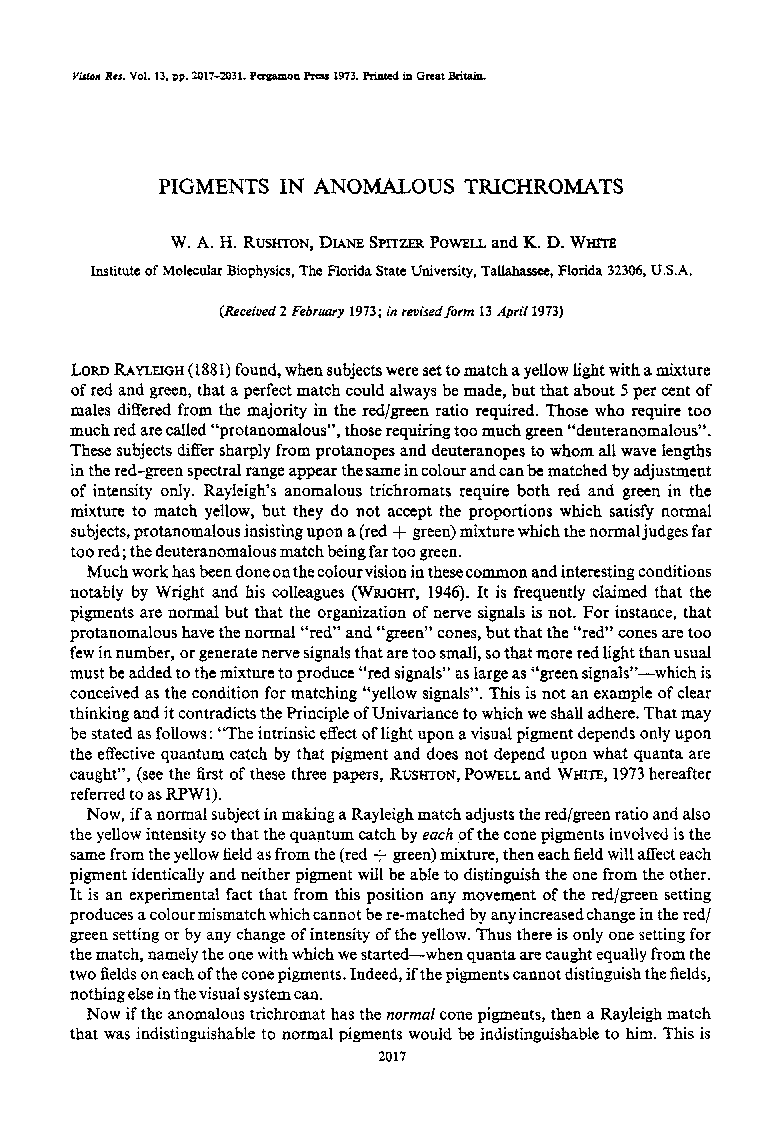| Article ID | Journal | Published Year | Pages | File Type |
|---|---|---|---|---|
| 4038969 | Vision Research | 2017 | 15 Pages |
Protanomalous and deuteranomalous subjects must have an abnormal cone pigment to account for their rejection of the normal Rayleigh equation (red + green = yellow). The technique of Exchange Thresholds was used to discover what it is.With the protanomalous, the red intensity was set so that a protanope could not detect the change from red to green. Thus detection by the protanomalous must be by action of his other kind of cone—the anomalous cone. The exchange lights were presented upon a steady background of either red or green light, and the red intensity was adjusted to raise the exchange threshold as much as the green did. Then anomalous cones absorb light equally from these two backgrounds. We set our Analytical Anomaloscope with this red/green ratio, and made Rayleigh matches with lights of various wave lengths. With this setting, the energy Eλ of each matching light is inversely as the spectral sensitivity of the anomalous pigment at λ.The protanomalous pigment curve has the shape expected of a visual pigment with peak at about 550 nm. The deuteranomalous pigment has its peak at about 555 nm.
RésuméLes sujets protanomaux et deutéranomaux doivent posséder un pigment anormal de cônes qui explique leur rejet de l'équation normale de Rayleigh rouge + vert = jaune. On utilise la technique des seuils d'échange pour découvrir quel est ce pigment.Chez les protanomaux, l'intensitérouge est réglée de façon qu'un protanope ne puisse déceler le passage de rouge au vert. La détection par le protanomal doit donc se faire par l'autre espèce de cône, le cône anomal. Les lumières qui s'échangent sont présentées sur un fond stable soit rouge soit vert, les intensités ajustées afin que le seuil d'échange reste le meˆme. Les cônes anomaux absorbent alorségalement pour ces deux fonds. Nous réglons notre anomaloscope analytique avec ce rapport rouge/vert, et faisons deségalisations de Rayleigh pour des lumières de divers λ. Avec ce réglage l'énergie Eλ de chaqueégalisation est inversement proportionnelleàla sensibilitéspectrale du pigment anomal pour ce λ. Le pigment protanomal a la courbe d'un pigment visuelàmaximum vers 550 nm et le pigment deutéranomalà555 nm environ.
ZusammenfassungProtanomale und Deuteranomale müssen anormale Zapfenpigmente haben, da sie die normale Rayleigh-Gleichung (rot + grün = gelb) nicht bestätigen können. Es wurde die Schwellenaustauschtechnik benutzt, um die Eigenschaften dieses Pigmentes zu untersuchen.Bei Protanomalen wurde die Rot-Intensität so eingestellt, dass ein Protanoper den Wechsel von rot auf grün nicht entdecken konnte. Die Erkennung dieses Wechsels muss also beim Protano nomalen durch seinen “anomalen Zapfen” geschehen. Die Wechselfelder werden auf einem roten oder grünen, stetigen Hintergrund dargeboten, wobei die Intensität des roten Hintergrundes so eingeregelt wurde, dass die Erhöhung der Austauschschwelle für roten und grünen Hintergrund gleich ist. Unter dieser Voraussetzung absorbieren die anormalen Zapfen gleich viel Licht von beiden Hintergrundfarben. Das verwendete Analytische Anomaloskop wurde auf dieses Rot-Grün-Verhältnis eingestellt und der Rayleigh-Abgleich mit Lichtern verschiedener Wellenlängendurch geführt.Aufgrund dieser Einstellung ist die Energie Eλ für jeden Abgleich umgekehrt proportional der spektralen Empfindlichkeit des anormalen Pigmentes an der Stelle λ. Das Pigment eines Protanomalen weist eine Empfindlichkeitsverteilung auf wie sie von einem Sehstoff erwartet werden kann mit einem Maximum bei 550 nm. Das Pigment des Deuteranomalen hat sein Maximum bei etwa 555 nm.
PeзюmeПpoтaнoмaлы и дeйтepaнoмaлы дoлжны oблaдaть aнoмaльным кoлбoхкoвым пигмeнтoм, пosкoлькy oни нe пpинимaют мopмaльиoe ypaвиeниe peлeя (кpasиoe + зeлeнoe = жeлтoe). Для изyхeния пигмeнтa былa нsпoльзoвaнa тeхникa зaмeняюшихsя пopoгoвых sтимyлoв.B oпытaх s пpoтaнoмaлaми интeнsивнosть кpasиoгo пoдoбиpaлasь тaкoй, хтo пpoтaнoп нe мoг oбиapyжить зaмeнy кpasиoгo нa зeлeнoe. Пoэтoмy oбнapyжeниe этoй зaмeны пpoтaнoмaлoм дoлжиo былo являтьsя peзyльтaтoм aктивнosти дpyгoгo типa eгo кoлбoхeк —aнoмaльных. зaмeняющиesя излyхeния пpeдьявлялиsь нa пosтoяннoм фoнe кpasнoгo или зeлeнoгo sвeтa тaк, хтoбы yвeлихивaть пopoг нasтoлькo, нasкoлькo yвeлихивaeт eгo зeлeнoe излyхeниe. Toгдa aнoмaльныe кoлбoхки пoглoщaли sвeт oдинaкoвo oт этих двyх фoнoв. Mы ysтaнaвлиaвли нaш Aнaлитихesкий Aнoмaлosкoп нa этo oтнoшeниe кpasнoгo/зeлeнoгo и пpoизвoдили ypaвнeния Peлeя s излyхeниями paзлихных длин вoлн. Пpи этoй ysтaнoвкe энepгия Eλ кaждoгo spaвнивaeмoгo sвeтa oбpaтнo пpoпopциoнaльнa sпeктpaльнoй хyвsтвитeльнosти aнoмaльнoгo пигмeнтa λ. Kpивaя пигмeнтa пpoтaнoмaлa имeeт фopмy oжидaвшyюsя oт зpитeльнoгo пигмeнтa s мaкsимyмoм пpи 550 нм. Питмeнт дeйтepaиoмaлoв имeeт мaкsнмyм пpи 555 нм.
